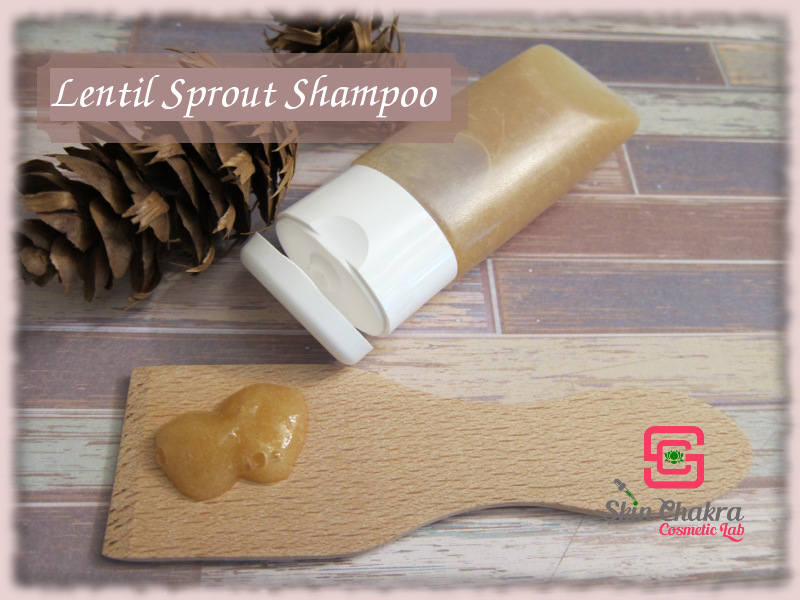
Sonntag, 25. Februar 2018
Lentil sprout shampoo
We haven't published many hair care tutorials during the last couple of years and since our range of hair care ingredients, and the demand for making natural, PEG-free and sulfate-free hair care is expanding, there are many inquiries from our readers and customers asking us to share some of our formulations as guidelines.
About the ingredients:
Here we are, sharing a mild and lovely shampoo with you. It is no secret that I love yucca extract and as you can say from the colour, I've used it here as well. Each time I decide to use a pretty colourful extract in my shampoo and shower gel formulations I end up with adding yucca extract (which unfortunately dominates the colour). I promise to make and share a yucca-free shampoo in the near furture.
I have applied two other mild and exciting surfactants to this shampoo:
Proteol APL EF : Sodium cocyl apple amino acids
Oramix L30: Sodium Lauroyl Sarcosinate
Both are mild, natural, PEG- and sulfate free anionic surfactants with a rich and fluffy foam.
To add some volume and texture to the shampoo, I use decyl glucoside in addition to the above surfactants and I've added coco-glucoside/glyceryl oleate as an emollient and foam booster to the formulation.
The preservative system:
Instead of water I've used hydrosols that are already preserved. However, the finished product needs to be preserved. I've used a blend of two preservatives that work here perfectly:
Versatil® BL and Dermosoft® 1388 eco
This preservative blend has worked in our aqueous and surfactant containing blends with efficacy. As always, I suggest that you test the efficacy of your preservative with preservative efficay or challenge tests.
Additives:
I've chosen one of my favourite hydroglyceric extract, beluga lentil sprout extract for this shampoo. Sprout extracts are full of minerals, antioxidants and vitamins. Feel free to use any other hydroglyceric, hydroglycoric or glyceric extract that you prefer.
Read our previous posts about sprout extracts:
From Sprout to Extract: why extracting sprouts (part I)
From Sprout to Extract: (part II)
Another additive I've used in this shampoo is natural (extracted from green tea) caffein. As you may know, caffein works against hair loss and stimulates hair growth.
Now let's got to the formulation and procedure.
Formulation:
Phase A
Organic rosemary hydrosol 25,0%
Organic verbena hydrosol (to) 100,0%
Hydroglyceric beluga lentil extract 2,5% (this is an ingredient we make for our own use and do not sell)
Na-PCA 2,0%
Na-lactate 2,0%
Panthenol 1,0%
Organic aloe powder 1,0%
Caffein powder 0,5%
Dermofeel PA-3 0,1%
Phase B
Organic and palm free glycerine 5,0%
Solagum AX 2,5%
Konjac gum 0,3%
Phase C
Proteol APL EF 10,0%
Oramix L30 12,0%
Decyl glucoside 5,0%
yucca extract 3,0%
coco-glucoside/glyceryl oleate 2,0%
Phase D
Organic rosemary essential oil 0,4%
Organic ginger essential oil 0,3%
Organic lemon verbena leaf oil 0,8%
Lactic acid (80,0%) to adjust the pH (about 1,8%)
Procedure:
1- Blend all the ingredients of phase A in a beaker. This is easily achieved with a spatula but you can use an overhead blender at low speed as well.
2- Blend gums in glycerine (use a small beaker and a spatula)
3- Blend the surfactant phase (phase c) in another beaker. We usually use a magnetic stirrer at a very low speed for this part
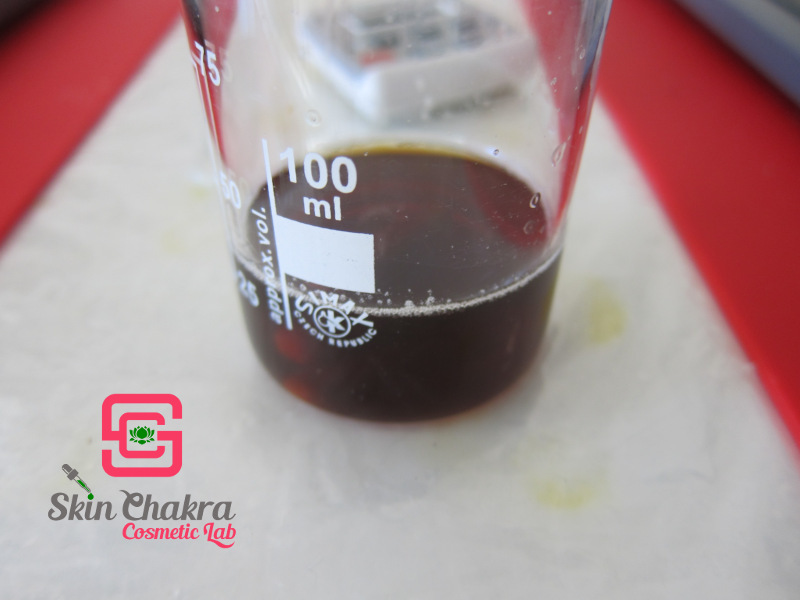
4- Start blending the gum/glycerine in the water phase (phase A). Although for small volumes a spatula may perfectly work, a suitable mixer makes the life much easier. This is the hardest part of making a surfactant containing product. If the gum is not perfectly dispersed and builds clumps, your shampoo would separate in two ugly phases after a few hours to few days. Read our previous blog post about gum dispersion. We usually use an overhead stirrer with a propeller blade at a very high speed for gum dispersion. Heating is not necessary (for most gums) but if you're using a viscosity modifier that needs heating or if you feel that heating the water phase makes the dispersion easier then go ahead and heat your water phase, just make sure you don't have any heat sensitive ingredient in that phase.
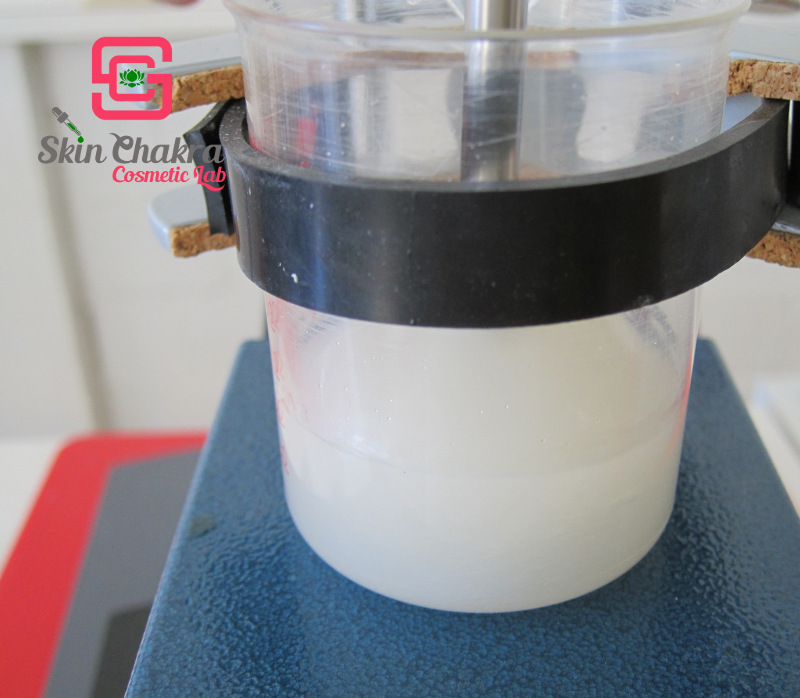
5- After you've dispersed the gum in the water phase slow down the mixer to a very slow speed (or use a spatula to blend manually but a manual blending creates more foam than an overhead stirrer) and slowly add the surfactant phase to the water+ gum phase. This steps takes a long time if you want to have as little air bubbles as possible
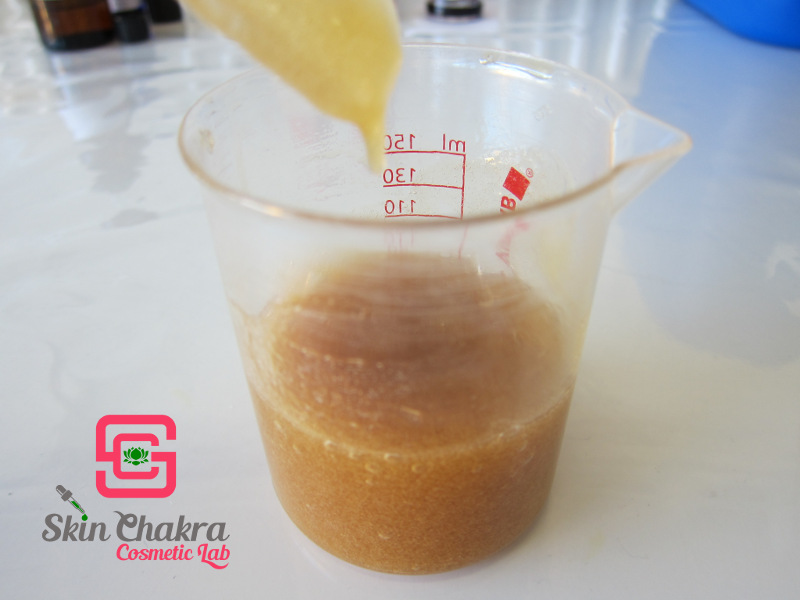
Keep in mind that in an industrial scale the mixers are either equipped with a deareation unit or a centrifuge unit to remove foam after mixing. This means your manually created shampoo will always have some air bubbles (which actually look quite pretty). The following photo demonstrates the difference in the appearance of a shampoo before and after centrifuge.
6- Now you can add your essential oils to the shampoo.
7- It's time to add the preservative. Prepare a 10% dilution of the shampoo in distilled water and measure the pH.
Read our previous blog posts about pH measurement:
https://skinchakra.eu/blog/archives/516-pH-measurement-in-cosmetic-lab-why-we-dilute-samples.html
and
https://skinchakra.eu/blog/archives/497-How-to-adjust-the-pH-of-your-cosmetic-products.html
The pH of this system is about 6,5 and you can add the preservative.
8- After blending the preservative into the shampoo, make another 10% dilution and measure the pH again. With this preservative blend, the pH remains around 6,5 and it means you need to add an acid to reduce the pH. We use 80% lactic acid for pH reduction but you can use citric acid as well.
9- Add the acid to the shampoo and prepare another 10% dilution and measure the pH. Ideally it should be between 5,3-5,5. If the pH is still higher than 5,5 add more acid to reduce the pH. Add your acid gradually and in small steps. if you add too much acid and reduce the pH to lower than 5, your preservative system will be kicked out of the shampoo and there is no way to bring it back to the system.
Read our previous blog post:
How to protect your "natural" preservatives from deactivation
for more information.
10- After you're satisfied with the pH take your micro kit and stability samples and fill the rest in a suitable bottle.
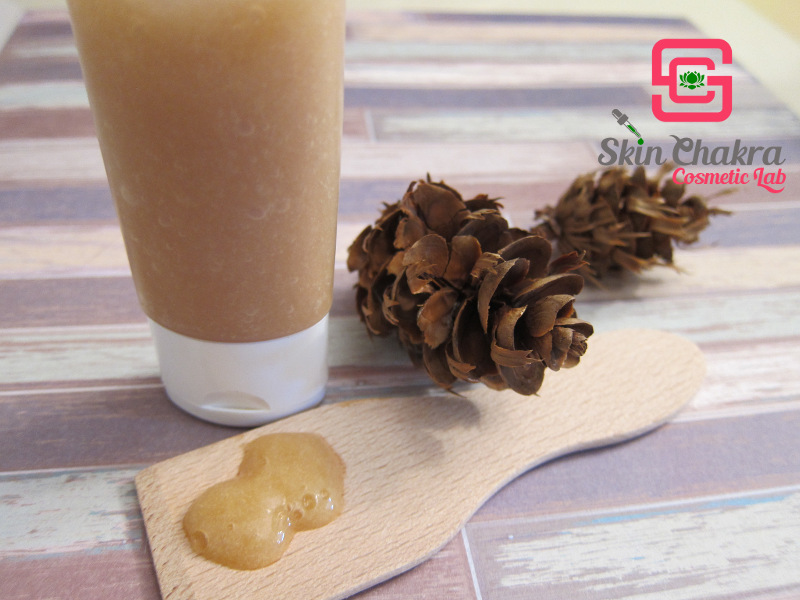
Enjoy your shampoo and don't forget to share your photos and experience with us.
BeHappy and have fun

